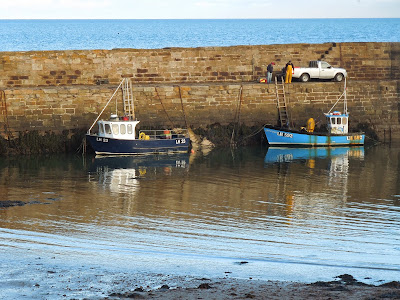Today's battle plan was to visit some really beautiful & amazing sea stacks & sea arches carved by the relentless battering of the waves & wind, but their location can be quite dangerous as when at high tide the sea is right at the base of the cliffs with no way up to safety so caution & vigilance is required at this location.
But first of all I headed for the hills for some leg work & to get the blood up to performance temperature & to collect some data for my old church gravestone project.
So what are we waiting for lets hit the rubber road ride to freedom !
Climbing uphill passing the farms of Blackcastle, Cocklaw & Stottencleugh on the way to Oldhamstocks to visit the church graveyard.
The church of Oldhamstocks with some really interesting gravestones for my research.
Cutting through a right of way from Oldhamstocks village to the grounds of Dunglass estate, passing by this horny sheep.
Dunglass estate.
Dunglass Collegiate Church lies just north of Cockburnspath. It was founded by Sir Alexander Home in 1444 and it's founding charter was confirmed by King James II and by the Pope in 1450. When originally founded it was staffed by a college of priests (hence the description "collegiate") comprising a provost, three chaplains, and four boy choristers.
The start of the pathway leading down to the famous Cove harbour. This monument is in honour of the fishermen lost at sea in 1881, just like the one that I say at St.Abbs when I cycled the Berwickshire Coastal Path.
Local fishermen hauling their equipment up onto the harbour pier.
The natural harbour at Cove has been used by local fisherman since the early 1600's & during the 1700's a number of efforts were made to improve it. These included the digging of the remarkable tunnel through the headland that still provides access to the beach, together with a series of side chambers used to store locally caught fresh fish & a wide range of smuggled goods from the continent. The side chambers continued to be used as changing rooms by hardy bathers until they were sealed up in 1981.
Views looking over & beyond the harbour.
Heading back uphill to the hamlet of the Cove & another bronze trail marker again like the one that I saw on the Berwickshire Coastal Path, this one depicting net making.
Some of autumn's golden tree's, top picture you can see the top of the Dunglass collegiate church poking through the tree's.
Dropping down to sea level again & this is where the journey gets a bit iffy as there is a lot of seaweed covered rocks to slide on & it's around a mile on foot clambering over these boulders with bike on the shoulders trying to stay on my feet !
Arch way centre of picture & another to the right.I can always make faces from the shape of these rocks !
The rock here seems to crumble in giant blocks.
As you can see this can be a hazardous place with nowhere to go if the tide cuts you off.
This arch has recently crumbled further & not before too long I reckon this will become another sea stack...
...just like this top heavy stack !
A very quiet place along here, not many people come along to see these arches I don't think too many people know that they are here.
Sedimentary rock dominate the cliffs further along the beach. It's quite amazing how these layers are formed over time, as you can see by the bottom photo there is a particular layer where there are fossils showing. I would love to know why the layers are different colours ?
Not sure what this tunnel is for ? I can't see what could of been mined here, it is the only mine along this section of coastline. There is a wooden wedge still embedded into the rock as you can see from the above photo & the top photo near to the top of the picture, I also can't see why this wedge is here other than to separate the layers of rock which maybe were used in building ? I haven't a clue with this one !!
(Top 2)- A large chunk of rock collapsed from the cliff face, with fossils between the split layers.
(Middle)- Fossilised beach on the top of this boulder.
(Bottom)- Washed up limestone fossil rounded by the tidal action.
Leaving the rocky shore behind & travelling along the deserted & pristine clean beach of Thorntonloch.
Cycling around the perimeter of Torness power station & the low autumnal sun making for a nice pleasant ride.
Lime production past & present.
Barns Ness lighthouse now just an ornament on the coast. Built between 1899-1901, automated in 1986 & sadly deactivated in October 2005.
A wee movie of some of the areas that I went.
I have to apologies for the picture quality, the picture is perfect but once I uploaded it to You-Tube the quality is not there :-/ so I will have to look into resolving this for the future !
Anyway thank you once again for looking at my blog & hope you enjoyed...
'Sea Stacks & Arches'
Until the next time bye for now.





















































































